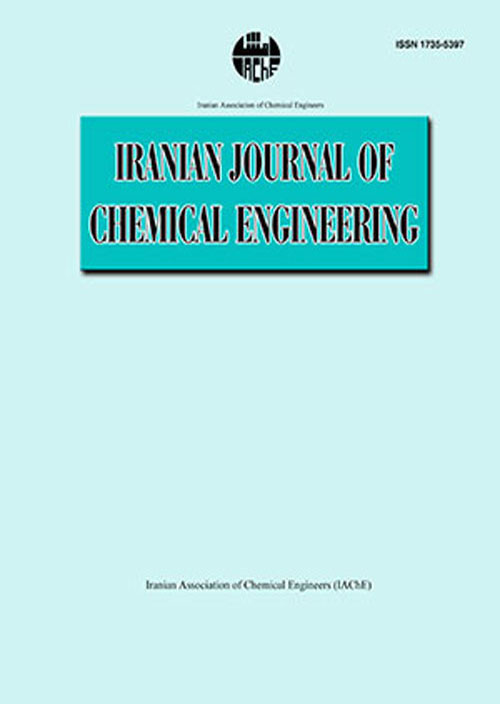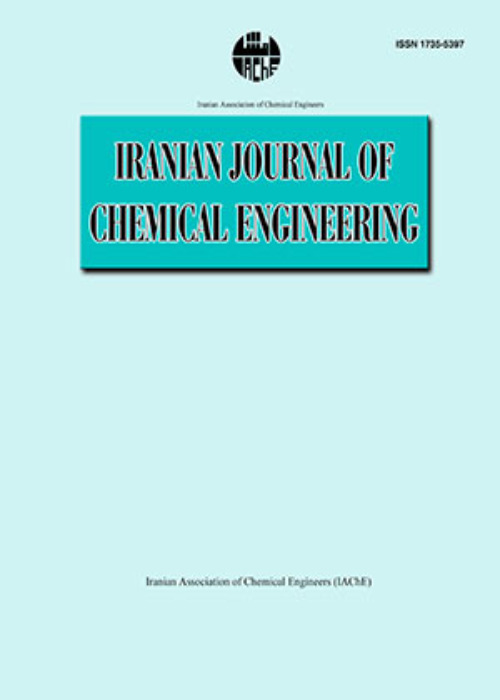فهرست مطالب

Iranian journal of chemical engineering
Volume:19 Issue: 1, Winter 2022
- تاریخ انتشار: 1401/08/09
- تعداد عناوین: 6
-
-
Pages 3-14
One of the methods to reduce particle size is the GAS method. In this method, solute and antisolvent should be dissolved well in a solvent. But solute is not dissolved in a solvent. The aim of this modeling study is to determine the phase equilibrium and thermodynamic conditions of (CO2, solvent, 5-Fluorouracil) in the GAS process. The solvents include methanol, ethanol, acetone, 1-propanol, and 1-butanol. Peng-Robinson equation of state with a linear combination of Vidal and Michelsen mixing rules (PR-LCVM) was used for thermodynamic modeling. The volume expansion of the binary system (CO2, solvent) and ternary system (CO2, solvent, 5-Fluorouracil) at the temperature ranges of 313.15–319.15 K were investigated. The Pmin for the binary system was 66.7, 69.6, 60, 73.7, and 76.8 bar for methanol, ethanol, acetone, 1-propanol, and 1-butanol at 313.15 K, respectively. The Pmin for the ternary system was also calculated. The comparison between the binary and ternary system values showed that for a constant temperature and a certain solvent, the calculated minimum pressure in the ternary system was greater than in the binary system.
Keywords: GAS process, Peng-Robinson, LCVM, Optimal Condition, 5-fluorouracil -
Pages 15-32
A batch process was developed for biodiesel production from high free fatty acid feedstocks. The mixed-integer nonlinear programming (MINLP) problem caused due to applying of hierarchical procedure together with Malone’s algorithm for conceptual design was solved. Meanwhile, the optimum states of major process parameters such as the utilization of process equipments, paralleling, splitting, and merging of unit operations, process cycle time (CT), and combination of batch and continuous units were determined. Based on the present optimization study, the optimum value of process cycle time and the optimum number of the esterification reactors in series were obtained as 3.257 h/batch and 3 stages, respectively. The batch process was found to be suitable for a capacity of less than 260 tons/yr, while the continuous process was suitable for a capacity of greater production rates. The results showed that the production rate had a direct effect on the economic potential of the process and that it should be set at its maximum possible practical value. Also, the break-even point at the optimum state occurred at 130 tons/yr of production rate.
Keywords: Batch process, Biodiesel, Conceptual design, Gantt chart, optimization, Process Cycle Time -
Pages 33-50
In the present investigation, physicochemical parameters studies of dyeing of woolen yarn with CI Acid Red 1 dye in terms of kinetics and thermodynamic of adsorption were studied. Different models (Zero order, first order, second order, Parabolic, cegarra Puente and modified cegarra puente models) were employed to identify an acceptable dyeing mechanism. It was found that the modified cegarra puente model best fitted to the experimental data with the highest correlation (R2≥0.99). The dyeing rate constant, the half dyeing times, rise time and fixation time were then calculated. Thermodynamic parameters, such as Gibbs free energy (∆G#), enthalpy (∆H#), entropy (∆S#), and the activation energy (Ea) were considered. The thermodynamic parameters imply that the dying process could be boosted by increasing system temperature. Also, dying of woolen yarns with CI Acid Red 1 decreases randomness and enhances the order of reaction systems by immobilizing dye molecules onto the solid fiber surface.
Keywords: CI Acid Red 1, wool, Kinetic modeling, Dyeing behavior, Modified Cegarra-Puente -
Pages 51-65
Adaptive neuro-fuzzy inference system (ANFIS) was applied to simulate batch adsorption of triglyceride (TG) from the human blood serum using cinnamon powder, which has appeared as a potential serum-contact biosorbent, in our previous work. Experimental results were used to train and evaluate the ANFIS model. Serum temperature, contact time, stirring rate, cinnamon dose and particle size were considered as the model inputs and TG removal percentage was chosen as the model response. ANFIS model was trained with 75% of the available data while, 25% of the remaining data was used to verify the validity of the data-based model. Sobol sensitivity analysis results indicated that the adsorbent dose with %71 and particle size of the cinnamon with %15 share impact were the most affective variables on the adsorption performance. The specific surface area and the reactive adsorption sites density were obtained to be the most important characteristics of the adsorbents. Results of this study confirmed the advantages of ANFIS and Sobol approaches for data-based optimization of bioprocesses.
Keywords: Data-based optimization, blood serum, Triglyceride, Adsorption, ANFIS, Sobol sensitivity analysis -
Pages 66-76
Bone tissue engineering require approaches to provide a suppression/promotion environment for bone growth. Scaffold biomaterials have profound regulatory effects on the functionality of mesenchymal stem cells (MSCs). In the present study, three-component bioceramic of selenium/reduced graphene oxide/hydroxyapatite (Se/RGO/HA) was developed and its performance to repair bone defects was compared to HA. The Se/RGO/HA nanocomposite scaffold was synthesized using the chemical bath technique, characterized by X-ray diffraction spectra, Field emission scanning electron microscope, Energy dispersion X-ray spectrometer, and Fourier transform infrared spectroscopy analyses. Human adipose-derived MSCs (hAD-MSCs) were used to investigate the in-vitro osteogenic properties of Se/RGO/HA scaffold. The effect of combined scaffold on cell proliferation was analyzed by MTT assay. Cell adhesion behaviors was evaluated using optical microscopy and SEM. The osteogenic properties of Se/RGO/HA scaffold was examined by the measurement of alkaline phosphatase (ALP) activity and western blotting technique. The hAD-MSCs proliferation for HA, Se/RGO/HA nanocomposite were 2±0.1 and 1.1±0.05 respectively. The Se/RGO/HA nanocomposite had cytotoxic effect of on the KHOS-240S cancer cells . Additionally, good cell attachment and osteoblast-like morphology were characterized on the designed scaffold. The ALP activity and mineralization potential of cells seeded on Se/RGO/HA were higher than those seeded on HA. The Osteocalsin protein for Se/RGO/HA and HA were 64±1 and 12±0.1 respectively. Furthermore, the expression of Osteocalcin, a bone-specific protein, was synergistically increased by incorporation of Se and RGO into HA. In conclusion, the presence of RGO inside the Se could significantly increase positive effects of HA on the osteogenic potential of hAD-MSCs.
Keywords: graphene oxide, Bone scaffold, Regeneration, Hydroxyapatite -
Pages 77-89
MXene membranes perform well in biofuel separation due to their excellent hydrophilicity, flexibility, and mechanical strength. For the first time, computational fluid dynamics was used to model ethanol dehydration through the pervaporation system by the MXene membrane. We discretized the momentum and continuity equations using finite element methods and predicted the mass transport. Experimental results and model data were in good agreement (less than 10%). The feed velocity, feed concentration, and membrane thickness all had positive effects on the separation factors while the temperature had a decreasing effect. This model's efficiency has decreased by 35% after increasing feed flow rate by 10 times. In addition, the separation factor increases tenfold when temperature is raised from 25 to 70°C.MXene membranes perform well in biofuel separation due to their excellent hydrophilicity, flexibility, and mechanical strength. For the first time, computational fluid dynamics was used to model ethanol dehydration through the pervaporation system by the MXene membrane.
Keywords: Biofuel, dehydration, Pervaporation, MXene, CFD


